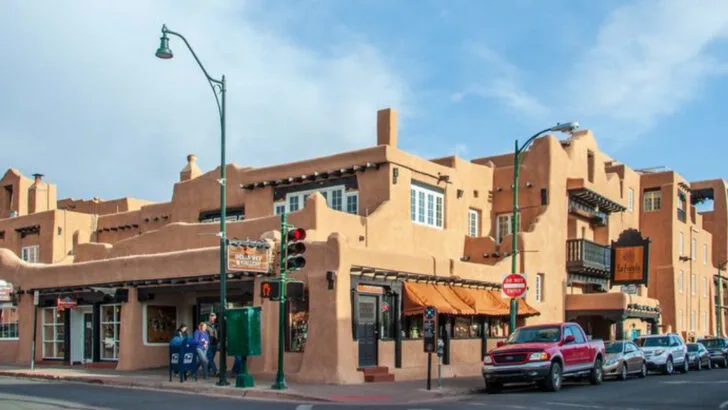New Mexico is a place where two worlds never collided—they blended, layer by layer, into something unforgettable. In its small towns, Spanish colonial history doesn’t just sit in museums; it lives in adobe walls, mission churches, and plazas that still pulse with centuries of stories. Walk a few steps further, and you’ll find Native American traditions shaping the same spaces—artwork, festivals, and communities that hold ties to the land stretching back thousands of years. The result is not contrast but harmony, a cultural weave that feels richer than either side alone.
These towns aren’t just destinations. They’re living crossroads where food carries ancient recipes, architecture whispers of conquest and resilience, and every festival feels like stepping into two timelines at once. To wander through them is to stand inside history—one foot in the Spanish past, the other in Native roots, both firmly in New Mexico’s present.
Santa Fe
Santa Fe, the heart of New Mexico, boasts a vibrant fusion of Spanish and Native American cultures. The historic plaza, lined with Pueblo-style buildings, reflects its colonial past. Here, Native American artisans display handcrafted jewelry and pottery, offering a glimpse into their rich traditions.
Visitors can explore the Palace of the Governors, the oldest public building in the U.S., where history comes alive. The town’s annual Santa Fe Indian Market showcases the best of Native American art, drawing artists and collectors worldwide. A visit to Santa Fe is a journey through time, culture, and artistry.
Taos
Taos is a captivating blend of ancient and colonial history. At its core is Taos Pueblo, a UNESCO World Heritage Site, inhabited for over a thousand years. These adobe structures stand as a testament to Native resilience and creativity.
Spanish influence is evident in the town’s mission church, San Francisco de Asis, known for its iconic architecture. Taos’ vibrant arts scene, coupled with its breathtaking landscapes, attracts creatives from around the globe. This town is a living canvas, where every corner tells a story of cultural interplay and historical depth.
Albuquerque
Albuquerque’s Old Town is a vibrant area blending Spanish colonial charm with Native American heritage. Streets lined with adobe buildings house galleries and shops featuring authentic crafts and art.
The Indian Pueblo Cultural Center offers a deep dive into the Pueblo peoples’ traditions and history. Annual events, like the Gathering of Nations Powwow, celebrate Native American cultures with music, dance, and crafts. Albuquerque is more than a city; it’s a living museum where past and present merge beautifully, offering a unique cultural experience to its visitors.
Chimayó
Nestled in the hills, Chimayó is known for its spiritual significance and cultural blend. The Santuario de Chimayó, often called the “Lourdes of America,” attracts thousands of pilgrims seeking healing.
This town is a center for traditional weaving, with local artisans preserving time-honored techniques. The surrounding landscape, rich in Native American history, adds to its mystical aura. Chimayó represents a harmonious blend of faith, art, and history, where every visitor can feel a deep connection to the past and present.
A visit here is both a cultural and spiritual journey.
Las Cruces
Las Cruces, nestled in the Mesilla Valley, is a city rich in history and cultural diversity. Its proximity to ancient Native American sites like the Three Rivers Petroglyphs adds historical depth.
Spanish influences are evident in the town’s architecture and annual events, such as the Las Cruces Mariachi Conference. The blend of cultures is celebrated through music, dance, and culinary traditions that welcome visitors warmly.
Las Cruces stands as a beacon of cultural harmony, where the stories of its past continue to inspire a vibrant, diverse community.
Socorro
Socorro, with its historic mission church, offers a window into Spanish colonial history. The town’s name, meaning “succor” or “aid,” reflects its role as a place of respite for travelers.
Nearby, the Bosque del Apache National Wildlife Refuge showcases nature’s beauty, a significant aspect of Native American life. The town’s cultural events celebrate this blend of natural and human heritage, offering unique insights into local history.
Socorro is a place where the past meets the present, offering a gentle reminder of New Mexico’s rich and diverse cultural landscape.
Acoma Pueblo
Acoma Pueblo, known as “Sky City,” is one of the oldest continuously inhabited communities in North America. Perched atop a mesa, its adobe dwellings narrate tales of endurance and tradition.
Spanish colonial influence is evident in the San Esteban del Rey Mission, a testament to cultural confluence. Visitors can explore guided tours, learning about the Pueblo people’s history and artistry.
Acoma stands as a remarkable site of cultural preservation, where past and present coexist, offering profound insights into the enduring legacy of its people and their artistic expressions.
Zuni Pueblo
Zuni Pueblo is renowned for its rich artistic traditions and ancient history. Known for intricate silver and turquoise jewelry, Zuni artisans are celebrated for their craftsmanship.
The Pueblo itself is a vibrant community where ancient ways of life continue to thrive. Spanish colonial influences are visible in local architecture and religious practices, blending harmoniously with Native traditions.
A visit to Zuni offers a unique perspective on cultural resilience, where art and history intertwine, providing visitors with an enriching and immersive experience.
Espanola
Espanola, often called the “Heart of Northern New Mexico,” is a crossroads of culture. Its markets brim with Native American crafts, offering a colorful tapestry of local artistry.
Spanish colonial architecture is prominent in historic buildings and churches, adding to the town’s charm. Annual events celebrate this cultural blend, inviting visitors to partake in music, dance, and culinary traditions.
Espanola is a vibrant expression of New Mexico’s cultural diversity, where every street tells a story of shared history and community spirit.
Santa Clara Pueblo
Santa Clara Pueblo is famed for its pottery traditions, with artisans crafting pieces that reflect both ancestral and Spanish influences. The Puye Cliff Dwellings tell stories of ancient civilizations and cultural confluence.
Visitors can engage with the Pueblo community, experiencing traditional dances, feasts, and crafts. These cultural expressions offer deep insights into the Pueblo’s way of life.
The Pueblo is a testament to the enduring spirit of its people, where every artifact and tradition speaks volumes about their rich heritage and cultural synthesis.
Bernalillo
Bernalillo, located along the Rio Grande, is a town where history and culture converge beautifully. Spanish colonial buildings and Native American influences create a unique ambiance.
The annual Las Fiestas de San Lorenzo is a highlight, celebrating this blend with music, dance, and traditional foods. These festivals offer a glimpse into the town’s vibrant community life and diverse heritage.
Bernalillo stands as a symbol of New Mexico’s rich cultural tapestry, where every festival and street corner narrates a story of harmony and celebration.

